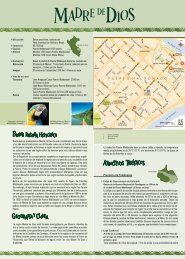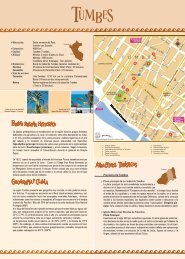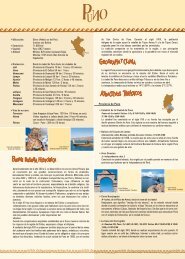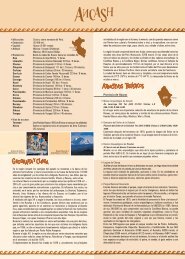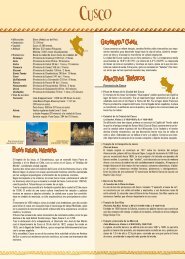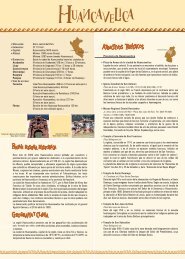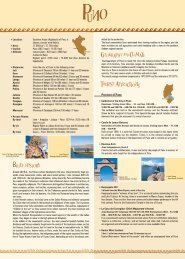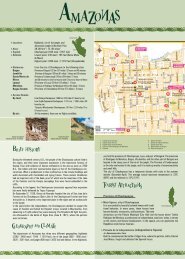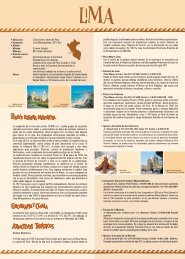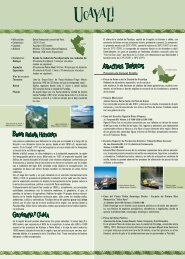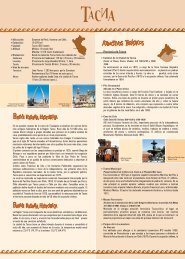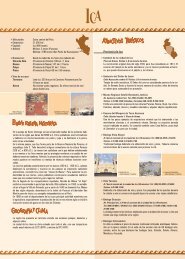Province of Arequipa - South American Destination
Province of Arequipa - South American Destination
Province of Arequipa - South American Destination
Create successful ePaper yourself
Turn your PDF publications into a flip-book with our unique Google optimized e-Paper software.
A.M. – 12:00 P.M. and 3:00 P.M. – 5:00 P.M. Email: convento-larecoleta@terra.com.pe<br />
A Franciscan convent founded in 1848, open to the public since 1978. It<br />
features various styles that include Romantic and Neo-gothic styles due to its<br />
different remodeling campaigns (the last one in 1940). It has four cloisters and<br />
eleven sectors, as well as two pre-Colombian art rooms, two others dedicated to<br />
the Amazon Rain Forest, and another to religious art. It also has a gallery<br />
exhibiting canvasses from the Cusco and <strong>Arequipa</strong> Schools and a valuable library<br />
that protects more than 20.000 volumes and ancient books.<br />
Iglesia y Convento de Santo Domingo (Church and Convent <strong>of</strong> Santo<br />
Domingo)<br />
Intersection <strong>of</strong> Calle Santo Domingo and Calle Rivero. Telephone: (054) 21-<br />
3511. Visiting hours: Mon. – Sat. 7:00 A.M. – 12:00 P.M. and 3:00 P.M. – 7:30<br />
P.M. Sundays 5:45 A.M. – 1:00 P.M. and 6:30 P.M. – 7:45 P.M.<br />
Architecturally, the church is characterized by a bell tower, its entrance with a<br />
corner pedestal, and its impeccable arch under the choir l<strong>of</strong>t. Inside, one can<br />
appreciate paintings and other pieces <strong>of</strong> sacred art.It is also known for its side<br />
entrance being the oldest in <strong>Arequipa</strong>. The upper cloister <strong>of</strong> the convent was<br />
constructed around 1734.<br />
Casa del Moral (Moral House)<br />
Calle Moral 318, downtown <strong>Arequipa</strong>. Visiting hours: Mon. – Sat. 9:00 A.M. – 5:00<br />
P.M. Holidays 9:00 A.M. – 1:00 P.M.<br />
An eighteenth century house, constituting one <strong>of</strong> the oldest and most important<br />
architectural monuments from the <strong>Arequipa</strong> Baroque period. The house owes its<br />
name to an ancient blackberry tree that grows in its main patio. Inside, furniture<br />
from Peru’s Colonial and Republican epochs is on display. The main entrance <strong>of</strong><br />
white sillar stone is a work <strong>of</strong> art in which you can admire carefully carved<br />
figures. For example, there is a crown suspended above a coat <strong>of</strong> arms that is<br />
held up by two angels, the coat <strong>of</strong> arms is composed <strong>of</strong> tinier carvings <strong>of</strong> a<br />
castle, a bird, a puma, and two crossed keys. In the same way, the room <strong>of</strong><br />
sixteenth century “antique” maps <strong>of</strong> America stands out.<br />
Barrio de San Lázaro (Saint Lazarus neighborhood)<br />
Five blocks from the Main Square, <strong>Arequipa</strong>.<br />
This neighborhood <strong>of</strong> alleys, narrow passageways, small plazas, and large homes<br />
is the most representative <strong>of</strong> old <strong>Arequipa</strong>. This place was established by<br />
Dominican priests in 1538, who built a sanctuary to evangelize the natives <strong>of</strong> the<br />
area and prepare the land to found a new Spanish city. The small bridge that<br />
connects the Church <strong>of</strong> San Lázaro and its small plaza with the rest <strong>of</strong> the<br />
quarter is worth a visit.<br />
Casa Goyeneche (Goyeneche House)<br />
Calle La Merced 201. Telephone: (054) 21-2251. Visiting hours: Mon. – Fri. 9:15<br />
A.M. – 3:00 P.M.<br />
This sixteenth century house <strong>of</strong> white sillar stone is completely designed in the<br />
Colonial style. Prints from the Cusco and <strong>Arequipa</strong> Schools are preserved there<br />
as well as sculptures from the Granada School <strong>of</strong> the seventeenth century. The<br />
name comes from Mr. Juan de Goyeneche y Aguerreverre, who bought it in<br />
1782. Presently, it is headquarters to the Central Reserve Bank <strong>of</strong> Peru in<br />
<strong>Arequipa</strong>.<br />
Iglesia San Agustín (Saint Augustine Church)<br />
Intersection <strong>of</strong> Calle San Agustín and Calle Bolívar. Telephone: (054) 22-0066. Visiting<br />
hours: Mon. – Sat. 8:00 A.M. – 12:00 P.M. and 5:00 P.M. – 7:00 P.M. Sundays 8:00<br />
A.M. – 1:00 P.M. and 5:00 P.M. – 7:00 P.M.<br />
Built in 1575, the church displays a façade that dates from the first half <strong>of</strong> the<br />
eighteenth century and is considered one <strong>of</strong> the best <strong>of</strong> its time. In architectural terms,<br />
it belongs to the mixed-origin Baroque and the main construction material is white sillar<br />
stone. Inside, the main highlights are the dome, its Neoclassical altars, especially the<br />
major one, for the precise carvings and gilding<br />
Iglesia La Merced (Mercy Church)<br />
Intersection <strong>of</strong> Calle La Merced and Calle Tristán. Telephone: (054) 21-3233.<br />
Visiting hours: Mon. – Fri. 8:00 A.M. – 1:00 P.M. and 4:00 P.M. – 7:00 P.M.<br />
Saturdays 8:00 A.M. – 12:00 P.M.<br />
Its construction began in 1551 and was completed in 1607. It has an attractive<br />
side entrance, which features the image <strong>of</strong> the Virgin <strong>of</strong> Mercy accompanied by<br />
two saints <strong>of</strong> mercy. Important works <strong>of</strong> art like the “Aparición de la Virgen a<br />
San Pedro Nolasco” (Saint Peter Nolasco Recovering the Image <strong>of</strong> the Virgin) are<br />
preserved in its sacristy as well as a series <strong>of</strong> paintings related to the Virgin de<br />
la Merced in the main hall. The church and the convent, the latter constructed in<br />
the city, were built using the white sillar stone from <strong>Arequipa</strong>. The cloister<br />
maintains a library that dates back to the Vice royal period.<br />
Casa Tristán del Pozo (Tristán del Pozo house)<br />
Calle San Francisco 108. Telephone: (054) 21-2209. Visiting hours: Mon. – Fri. 9:15<br />
A.M. – 12:45 P.M. and 4:00 P.M. – 6:00 P.M. Saturdays 9:30 A.M. – 12:30 P.M.<br />
This traditional, colonial house has a façade carved in mixed-origin Baroque. In<br />
addition, it was made with wide, unique patios inside. It was built in 1738 for General<br />
Domingo Tristán del Pozo. Today, it is the property <strong>of</strong> Banco Continental.<br />
Museo Arqueológico de la Universidad de San Agustín<br />
(University <strong>of</strong> San Agustín Archeological Museum)<br />
Intersection <strong>of</strong> Calle Álvarez Thomas and Calle Palacio Viejo. Telephone: (054)<br />
28-8881. Visiting hours: Mon. – Fri. 8:15 A.M. – 4:15 P.M.<br />
A varied collection is exhibited here including stone items, bones from human<br />
sacrifices, ceramic pieces from the Nasca, Tiahuanaco, Huari, and Inca, and<br />
objects <strong>of</strong> gold and silver from the Colonial and Inca eras.<br />
Museo de Arqueología de la Universidad Católica de Santa María de <strong>Arequipa</strong><br />
(University <strong>of</strong> Santa María de <strong>Arequipa</strong> Archeological Museum)<br />
Calle Cruz Verde 303. Telephone: (054) 95-9636. Visiting hours: Mon. – Fri. 9:00<br />
A.M. – 12:00 P.M. and 2:00 P.M. – 5:00 P.M.<br />
The museum has around 1000 pieces (ceramics, textiles, mummies, works <strong>of</strong><br />
stone, wood, and metal) from the different cultural groups that inhabited the<br />
Department <strong>of</strong> <strong>Arequipa</strong> from 12.000 B.C. up to the time <strong>of</strong> the colony: Nasca,<br />
Tiahuanaco, Wari, Churajón, Acarí, Aruni and Inca as well as transitional and<br />
colonial materials.<br />
Museo Santuarios Andinos de la Universidad Católica de Santa María<br />
(Catholic University <strong>of</strong> Saint Mary)<br />
Calle La Merced 110, downtown <strong>Arequipa</strong>. Telephone: (054) 21-5013. Visiting<br />
hours: Mon. – Sat. 9:00 A.M. – 6:00 P.M. Sundays 9:00 A.M. – 3:00 P.M.<br />
Here, they exhibit la Dama de Ampato (the Lady <strong>of</strong> Ampato), an Inca mummy <strong>of</strong><br />
a twelve to fourteen year old girl found at the top <strong>of</strong> the Ampato volcano by the<br />
climber Miguel Zárate, the archeologist José Chávez, and the anthropologist<br />
Johan Reinhard on September 8, 1995. According to the specialists, it is very<br />
likely that the girl, whose remains were found frozen, died from a blow to the<br />
temple from a five pointed granite mace. It seems that she was sacrificed to the<br />
Ampato Apu (protector god) some 500 years ago.<br />
Urbanización Selva Alegre (Selva Alegre suburb)<br />
Considered the “garden <strong>of</strong> the city” for its large parks and huge trees that live in<br />
harmony with the modern houses <strong>of</strong> the area, Selva Alegre was constructed as<br />
a monument to Juan Pablo Vizcardo y Guzmán, fore runner <strong>of</strong> the Peruvian<br />
independence. The Molino de Santa Catalina (Mill <strong>of</strong> Saint Kathleen) is another<br />
site to visit, completely restored and located on the mall <strong>of</strong> this zone.<br />
Yanahuara Lookout<br />
2 km / 1 mile from downtown <strong>Arequipa</strong> (8 minutes by car)<br />
It was built in the nineteenth century and is composed <strong>of</strong> a series <strong>of</strong> sillar stone<br />
arches where the words <strong>of</strong> famous <strong>Arequipa</strong> citizens have been engraved. This<br />
spot is a wonderful view point <strong>of</strong> the city and Mount Misti volcano.<br />
City <strong>of</strong> Sabandia<br />
8 km / 5 miles from <strong>Arequipa</strong> (20 minutes by car)<br />
Wide terraces and three volcanoes, the Misti, the Chachani, and the Pichu Pichu,<br />
provide the scenery around this traditional town. Some <strong>of</strong> the houses still<br />
preserve characteristic styles <strong>of</strong> the Viceroyalty or <strong>of</strong> the nineteenth century<br />
Republicanism. A recreational area with two swimming pools that use the cold<br />
river waters <strong>of</strong> the surrounding region has been built.<br />
Molino de Sabandía (Sabandía Mill)<br />
Located in Sabandía<br />
Constructed in 1785, it represents the typical architecture <strong>of</strong> the zone where the<br />
use <strong>of</strong> sillar stone predominates. It is characterized by solid supports and rustic<br />
balconies. Stone grinding wheel techniques for wheat processing can be viewed<br />
here as well.<br />
Mansión del Fundador (Founder’s Mansion)<br />
9 km / 6 miles from <strong>Arequipa</strong> (15 minutes by car)



